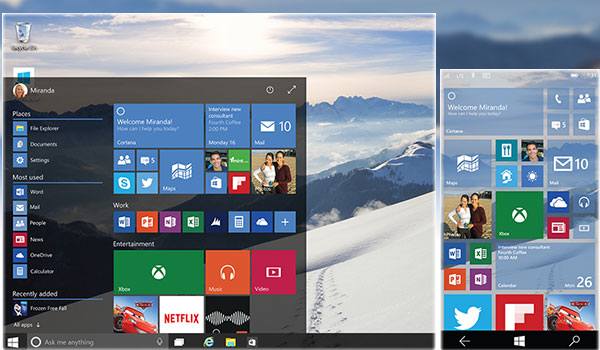I’m well into the user testing of the next generation of Microsoft’s operating system and things are really looking up. Windows 10 is becoming a blend of the many things we liked about Windows 7, and the things that most folks don’t know about that are great about Windows 8. The product is like a breath of fresh air, or for those truly annoyed with Windows 8, like the feeling you get when you stop hitting your head against the wall.
Ironically, it’s likely that the folks who hate Windows 8 will likely love Windows 10 the most. But Windows 10 begs the question, what is the ideal hardware for a product that spans smartphones, tablets, PCs and the Hololens? You could argue it’s Hololens, but that product is still in its infancy and won’t mature for at least 3 to 5 years, and by then we’ll be on a future iteration of Windows better designed for it.
Let’s talk about what the perfect Windows 10 hardware might be — and I’ll close with my product of the week: a unique service that could help a loved one living far from home feel more loved, called Geek Fuel.
Picking the Perfect Product
Looking back at all of the versions of Windows, the quintessential Windows 95 PC was a tower form factor desktop PC, in anything but off-white, with a 15 inch monitor. This carried through till Windows 2000, when we seemed to go back to an off-white desktop form factor (at the time, the focus was on missing the Y2K disaster that didn’t happen).
Windows XP truly embraced the concept of the Windows Tablet, which didn’t turn out to be that successful. Windows Vista didn’t seem to have a hardware focus, which was part of its problem (it effectively was the new hardware you didn’t buy), Windows 7 was the Ultra Book (similar to a MacBook Air), and Windows 8 danced badly between hybrid and convertible products.
But Windows 10 is a very different beast. Yes, it fixes the bad design of Windows 8 and should be vastly better for those buying hybrid or convertible products, but it also scales from smartphones up to the Hololens, which makes this product more about breadth than any single form factor.
I could take the easy way out, like Time Magazine did a few years ago when they made everyone person of the year, by suggesting that Windows 10 ideal platform is everything — but I thought that move by Time was a cop-out and I’d feel the same about this decision.
Modular PC
Now, the ideal product for a platform with scaling that goes from handheld devices to full-on tower gaming machines would be the old Modular PC concept that IBM came out with in the late 90s. This concept has been bouncing around for the last decade — and I was even involved as a board member of a now disbanded company that was trying to bring the concept to market.
The concept was: you start with a small common module that would contain the operating system and your unique personality and apps, and then plug this module into a different carrier, which would morph it into what you’d want to do. Plug it into a cellphone and you’d have a smartphone, plug it into a tablet and your stuff would be in a table, same for a laptop, desktop, or unique custom configuration.
Pretty cool, huh? Only problem is that the only firm currently working that model is Google with their Project Ara and I’m pretty sure they won’t be running Windows 10.
Cloud PC
Now you could fall back and say, wait a minute, with ever more capable cloud services like Microsoft’s Azure, Office 365 and OneDrive, you wouldn’t need a modular PC, you’d need a thin client platform that lived off the cloud. Then you’d simply log into the services you need and your personality would almost magically appear on your smartphone, tablet or PC. Processors, flash memory, and displays are priced at a small fraction of what they used to be — one of my favorite hybrid PCs of last year cost under US$200 — so you likely could add a Nokia smartphone and still be at a fraction of the cost of what a modular solution would cost you.
Only problem is that the only volume thin client effort currently in the market is Google’s Chromebook — and while I think it’d be funny if it were identified as the ideal Windows 10 platform — I doubt either Microsoft or Google would be amused. In addition, they don’t allow the platform to drift down into smartphones, so the solution would be incomplete anyway. (Anyone else noticing how Google is increasingly looking like a worse version of Microsoft in the 1990s?)
Intel Compute Stick
At CES, Intel launched a little known product called the Compute Stick. It ships with Windows for just under $150 (I found it on Amazon last week for $124). Currently, this is a Windows 8.1 device, but it could even be more ideal for Windows 10, because 10 works better with a keyboard and mouse. It is small, it is portable, and it should turn any monitor (touch or non-touch) into an all-in-one PC — and if someone made a portable HDMI monitor with touch (turns out a company called GeChic does for $400) you could turn this into a tablet and add a small Bluetooth keyboard, mouse, and monitor or HDMI TV…and you have a desktop PC.
In fact, if you have an HDMI interface in your car (the new stereo in my Jag has one) you even have a car computer.
There are two problems, the monitor and the Compute Stick weren’t designed to go together and so would be a little inelegant (though I’ve ordered this stuff and am going to try it) and we don’t have a phone solution.
Intel Smartphone
This brings us to the idea of using an Intel smartphone instead of the Compute Stick, and connecting to various size monitors (portable, desktop, or TVs) to allow it to morph into its modes. You’ll always have the phone with you, it certainly could have performance in line with the Compute Stick, and this would literally put Intel on the map in mobile phones with a solution that ARM couldn’t easily match. Intel came close to this concept with a product they co-developed with Asus called the PadFone X mini for Android.
The only problem is that Intel and Microsoft are on the outs on phones and Intel’s phone runs Android, while Nokia, Microsoft’s phone division, is ARM not x86, so you can’t scale the solution out of phones and tablets.
Intel could build one using x86 Windows, but they’d have to write apps that would do the phone features because those don’t really exist in Windows, or wrap the phone around Skype and connect it to a data service plan, which could be interesting, but that device doesn’t exist yet. We’re moving to VoIP (Voice Over IP) calling anyway — and this could be an interesting alternative — but it likely wouldn’t work without Microsoft’s blessing.
Wrapping Up: The Ideal Windows 10 Device Doesn’t Exist
I think the ideal Windows 10 device is closest to the Intel Skype phone I described above, but it clearly doesn’t exist yet and can’t unless Microsoft and Intel can come together again like they once did and create a different future. Until then, we can get close to this ideal with either an Intel Compute Stick or Nokia Phone, and a portable monitor or HDMI TV and accessories.
This suggests the ideal Windows 10 hardware may not show up until Windows 10.1 — or that there is a surprise coming from Microsoft and Intel we don’t know about yet. I’m hoping for the latter. The parts are all there.
Let’s see if these two firms, both with new CEOs, can create a bit of magic.
Product of the Week: Geek Fuel

For those of you who know me, you’ll recall that the biggest personal mistake I think I ever made was not to go on an interview with the firm that would become Microsoft, and instead went to work for my family. I made this decision largely because at the time I was afraid of moving away from where I’d lived my entire life — and given that most live and die within a small area — I know I’m not alone in that fear (I’ve since gotten over it).
The big problem with moving is feeling disconnected, unloved and forgotten. I ran into an interesting service that could help with this called Geek Fuel. It kind of reminds me of those adopt-a-child services that tell you that for a few bucks a month you can feed a child in Africa, except this is for the person that is away from home.

For just under $14 a month, a box of random goodies goes out to the geek of your choice reminding them that you care. Nothing overwhelming, more like cards, geeky toys, junk food, and t-shirts. Now, it’s clear that the word Geek applies here because I doubt this would appeal to someone on a sports or music scholarship, but for someone in any form of engineering or computer science this could be just the thing to perk them up when they are feeling down.
Since I am a geek, and proud of it, Geek Fuel touched my heart and the service is my product of the week.























































Currently getting Windows 10 compatible hardware is like looking for white elephant.
Hardware compatibility issue is big problem while working.
When I installed Windows 8 on my PC then I got hardware compatibility or driver issue for Bluetooth and Wi-fi.
I don’t know exactly same thing will happen with Windows 10 or not but some how will raise issue for Hardware compatibility.
It take some time to come out of this issue.